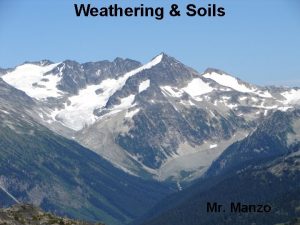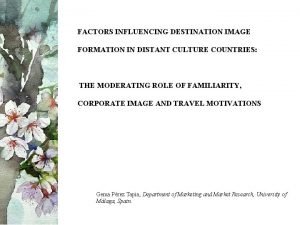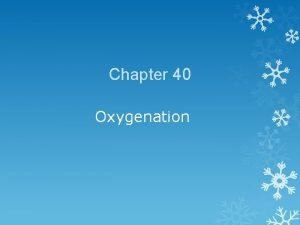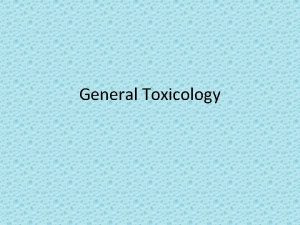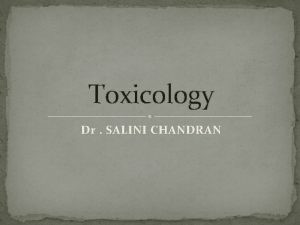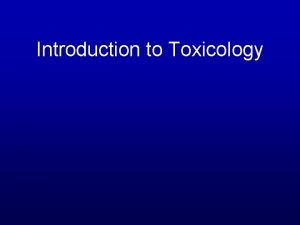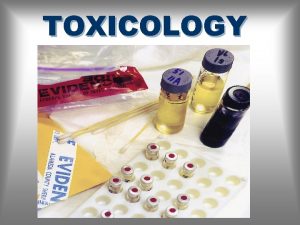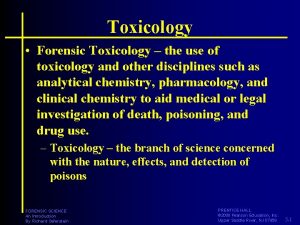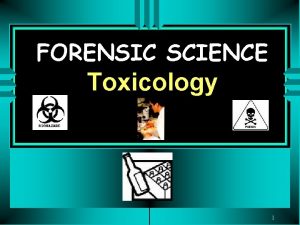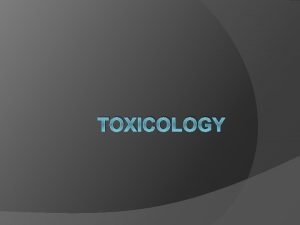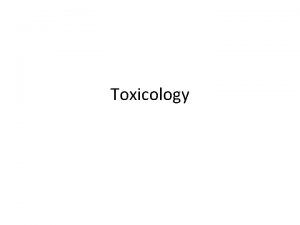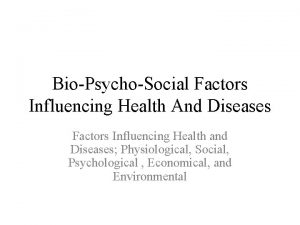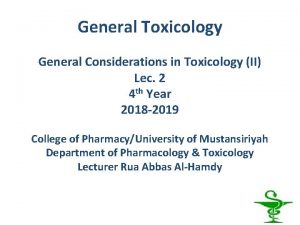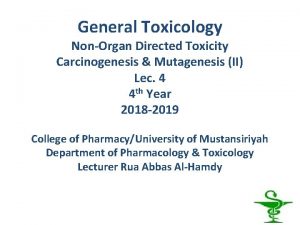General Toxicology Some Factors Influencing Toxicity Host Factors





















- Slides: 21

General Toxicology Some Factors Influencing Toxicity: Host Factors & Environmental Factors Lec. 7 4 th Year 2017 -2018 College of Pharmacy/University of Mustansiriyah Department of Pharmacology & Toxicology Lecturer: Rua Abbas Al-Hamdy

Lecture objectives: Objectives of this lecture are to determine host factors & environmental factors affecting toxicity with examples.

Among factors that influence toxicity are: § Host factors, & § Environmental factors.

Host factors: 1. Genetics 2. Gender 3. State of health 4. Age & maturity 5. Nutritional state & dietary factors

Genetics: § Pharmacogenetics describes the differences in an individual's response to drugs & chemicals that are related hereditary influences due to genetic polymorphism. § Examples: • Succinylcholine is a skeletal muscle relaxant that is often administered during the induction of general anesthesia. • The toxicologic problem arises because of the presence of an atypical pseudocholinesterase in a segment of the population.

• This would predispose them to a prolonged & life-threatening paralysis of respiratory muscles because the initial detoxifying step in succinylcholine metabolism is hampered. • Another example: individuals with erythrocytic glucose 6 -phosphate dehydrogenase (G 6 PD) deficiency are at special risk of toxicity to oxidizing agents, such as naphthalene, & sulfonamides. • When red blood cells (RBCs) are exposed to oxidizing agents, reduced glutathione (GSH) protects them from cellular injury & hemolysis.

• Regeneration of glutathione to its reduced form (GSH) again requires reduced nicotinamide adenine dinucleotide phosphate (NADPH) & glutathione reductase (Figure 1). Obviously, when G 6 PD is deficient, RBCs are unable to generate NADPH &, therefore, GSH function is impaired.

Figure 1. The role of glucose 6 -phosphate dehydrogenase (G 6 PD) in protection against oxidizing agents.

Gender: § Toxicologists are beginning to understand the differences in drug & chemical responses between men & women. § For example, • some studies report a sex-related difference in absorption of erythromycin, resulting in less drug being absorbed by women after oral administration.

• Another example, bioavailability of ethanol is greater in women than in men. This is associated with decreased gastric alcohol dehydrogenase activity in women, which contributes to reduced gastric oxidation of ethanol. This in turn may contribute to the enhanced vulnerability of women to acute & chronic complications of ethanol.

State of health: § The presence of hepatic or renal disease may significantly affect the pharmacokinetics & outcome of exposure to a particular toxicant. § Disease states that cause diarrhea or constipation may decrease or increase the time of contact between chemical & absorptive sites &, thus, reduce or enhance absorption.

Age & maturity: § Anticipated toxic effects are based on individuals who are either too young or too old. § The majority of accidental poisonings in fact occurs in persons less than 5 years of age. § An example of the effect of age & maturity on toxicity is the chloramphenicol-induced gray baby syndrome occuring in infants.

§ Chloramphenicol is normally metabolized & excreted largely as a glucuronide conjugate. Infants are unable to metabolize chloramphenicol because their hepatic microsomal enzyme system was not fully developed. Consequently, toxic concentrations of chloramphenicol would be reached after only a few doses. § In geriatric patients, the toxic effects of drugs & chemicals may be complicated by decreased hepatic & renal function. These factors may alter the metabolism or excretion of toxic agents.

Nutritional state & dietary factors: § In general, higher blood concentrations are achieved when drugs are taken on an empty as opposed to a full stomach. § Certain food may significantly increase or decrease drug absorption. For example, calcium may bind to tetracycline & reduce its absorption.

§ Some foods can actually increase the toxicity of certain drugs by means other than influencing their absorption. An excellent example are those foods that are rich in the pressor amine, tyramine. § If one of these foods is ingested while an individual is taking a monoamine oxidaseinhibiting drug (for example, phenelzine), sever symptoms of hypertensive crisis & even death may occur.

§ Tyramine-containing foods are ordinarily metabolized to a nontoxic substance by monoamine oxidase, which is located within the cells lining the GI tract. Therefore, only a small amount of tyramine is absorbed. § When monoamine oxidase is inhibited, tyramine is not metabolized but absorbed into the blood where it causes toxic pressor activity.

Environmental factors: 1. Temperature 2. Occupation

Temperature: § The response of a biologic system to a toxic agent generally decreased as environmental temperature is lowered, but the duration of overall response may be prolonged. § This is related to a decreased rate of absorption & a lowered rate of metabolic degradation & excretion in colder environments.

Occupation: § Persons working in industries where organic compounds, such as chlorinated hydrocarbon pesticides or volatile substances, are used may have an enhanced ability to metabolize drugs & chemicals. § The reason for this is that the chemical's presence in the environment may have caused the induction of liver microsomal enzyme activity.

§ The expected reaction to a toxic agent that is normally detoxified by the liver microsomal enzyme system would be reduced. § Of course, the reaction would be greater than normal for those substances metabolized to more toxic forms.

 Definitive host vs intermediate host
Definitive host vs intermediate host What are the factors affecting communication process
What are the factors affecting communication process Personality dynamics, meaning
Personality dynamics, meaning Which type of weathering
Which type of weathering Explain differential piece wage system with example
Explain differential piece wage system with example Physical factors influencing agriculture
Physical factors influencing agriculture Vertical component of projectile motion
Vertical component of projectile motion Contemporary nursing practice meaning
Contemporary nursing practice meaning Factors influencing trip attraction
Factors influencing trip attraction Pricing policy
Pricing policy A model of destination image formation
A model of destination image formation Factors influencing maternal health
Factors influencing maternal health Factors affecting wound healing local and systemic
Factors affecting wound healing local and systemic Factors influencing faculty staff relationship
Factors influencing faculty staff relationship The main goal of retail layout is
The main goal of retail layout is Facility network design logistics
Facility network design logistics Physical factors influencing agriculture
Physical factors influencing agriculture Factor affecting consensus
Factor affecting consensus Factors influencing chemical weathering
Factors influencing chemical weathering Factors influencing distribution network
Factors influencing distribution network Physiological factors affecting oxygenation
Physiological factors affecting oxygenation History of farming
History of farming



